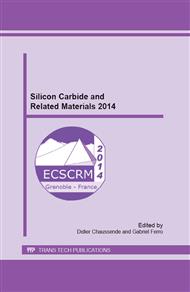p.596
p.600
p.604
p.608
p.612
p.616
p.620
p.624
p.628
The Effect of Proton and Carbon Irradiation on 4H-SiC 1700V MPS Diode Characteristics
Abstract:
Electronic properties of radiation damage produced in 1700 V 4H-SiC MPS diodes by proton and carbon irradiation were investigated and compared. 4H-SiC epilayers, which formed the lowdoped N-base of MPS power diodes, were irradiated to identical depth with 670 keV protons and 9.6 MeV C4+ ions. Results show that irradiation with both projectiles produces strongly localized damage (deep levels) peaking at ion’s projected range. Compared to protons, heavier carbon ions introduce more defects with deeper levels in the SiC bandgap and more stable damage. Radiation damage act as electron traps and compensates donor doping of the epilayer and decreases electron mobility. Forward voltage drop of irradiated diodes then sharply increases when the peak concentration of introduced acceptor levels donor doping. The effect of both the proton and carbon irradiation can be simulated using a simple model accounting only for one dominant electron trap.
Info:
Periodical:
Pages:
612-615
Citation:
Online since:
June 2015
Authors:
Keywords:
Price:
Сopyright:
© 2015 Trans Tech Publications Ltd. All Rights Reserved
Share:
Citation:


